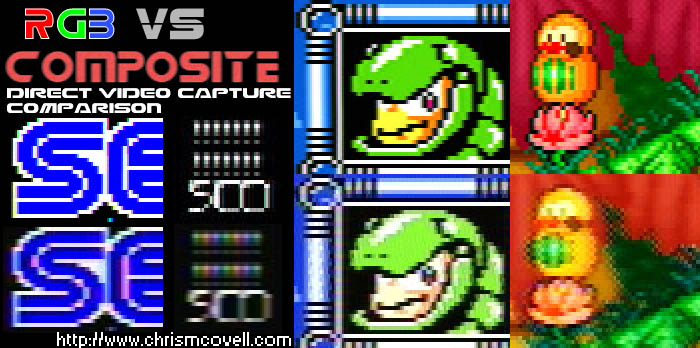

This is Page 1. Click here for Page 2 (Mega Drive).
A couple of years ago, I took a cheap USB video digitizer out of storage to play with it, and figured out a way to capture RGB video from my various game systems. What I did was jerry-rig the digitizer, which normally accepts either composite or S-Video, to take as a luminance signal one of the R,G,B channels paired with a sync signal. This made for a stable image which could be captured for each of the R,G,B channels in sequence. For game systems that output only composite+sync, I had to separate the sync signal using an AV Demiro box which contained a sync stripper. The quality of the captures is quite good, with only a small amount of visible noise in solid colour areas. Anyway, capturing RGB and composite using this method eliminates the need to take photographs of television or monitor screens, with no warping or phosphors getting in the way. Thus, much more direct comparisons between video outputs can be made as you can see below (by hovering your pointer over the images...) If you have any requests for specific game screens that you'd like to see compared in this way, send me a mail! |
Nintendo's system may be the first game system to have come with a 1st-party RGB cable as an option, so there's no excuse for yer Japanese folks for running it in anything less. The SFC's composite isn't that bad, as its PPU cycles around the colour burst artifacts with each frame.
Clarity problems do pop up, however, with fine text...
...and with bold colours placed together, like red and blue. Check out the crosstalk between the two hues. Also, notice how almost all the stars disappear in composite vs. what can be seen in RGB.
These don't look so bad in composite, thanks in a large part to the colour burst averaging that happens between successive frames on the NES/Famicom/SFC/PCE. Still, colours become faded and much less distinct. For example, hover over the Rockman 3 composite shot (without looking at the RGB shot.) What are the true colours of Magnet Man's and Shadow Man's eyes?
Sunsoft's artists really knew what they were doing on the Famicom. They blended their colours and used dithering methods that suited NTSC composite perfectly, creating lifelike, earthy tones that just might look better than RGB...
We can see that the PCE's output is pretty good as far as bold colour fidelity goes. Many of the shots below display very fine details in RGB that are even carried over in composite. The major noticeable difference, however, is the different colour balancing and component weighting which is a function of the PCE VCE's composite encoder.
Well, enough praise. With Daimakaimura, we can see that the 320-pixel mode of the PCE produces more blurring and NTSC artifacts which degrade the image quality somewhat. Also, there's still some unavoidable loss of colour definition in composite. For example, did you notice that in the Doraemon pic Nobita-kun has a bleeding knuckle? It's very hard to notice this with the PCE's composite.
Sega's 8-bit system is pretty notorious for its poor video quality. It smudges horizontal details all to hell, and introduces colour fringing and rainbows even in areas that contain only black & white!
The Neo-Geo actually has a very wide picture, meaning its 320 horizontal pixels are often too wide for most TV screens & monitors. So similarly, the left side of the screen is cut off in these video captures. Anyway, the NG's composite video is just horrible. It's a bit dark and muddy, even greyscale graphics get significantly blurred, and there's a horrible checkerboard interference pattern around strong colours.
Here's a little bonus. Of course the Game Gear has no video output per se, but by hacking it, RGB output can be realized. In my implementation, the video's a bit noisy thanks to digital signal interference, but it's still quite adequate for playing games (and 1000x better than the GG's built-in screen!)



